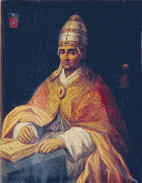1334 papal conclave
The 1334 papal conclave (13 December to 20 December) elected Jacques Fournier as Pope Benedict XII to succeed Pope John XXII.
| Papal conclave 1334 | |
|---|---|
| Dates and location | |
| 1334 Palais des Papes, Avignon | |
| Election | |
| Candidates | Jean-Raymond de Comminges |
| Ballots | ? |
| Elected pope | |
| Jacques Fournier Name taken: Benedict XII | |
 | |
Cardinals
Twenty-four cardinals attended the Conclave of December, 1334.[1] Their names are listed by Konrad Eubel in Hierarchia catholica.[2]
Politics
An early favorite among the papabile was Cardinal Jean-Raymond de Comminges, Bishop of Porto e Santa Rufina, son of Count Bernard VI of Comminges and Laura de Montfort. The French cardinals, led by Elie de Talleyrand-Périgord, naturally did not want to leave their native France for the plague-infested and unfriendly city of Rome. And since the Orsini faction did want to return to Rome, the Colonna faction chose the exact opposite, and joined the French.[3] A sufficient number of cardinals agreed to support him (2/3, or a minimum of 16 in number), and thus he could have been elected Pope, had he been willing to swear to a condition not to return the papacy to Rome.[4] Understandably, he refused his consent to the election on those terms.[5]
The Cistercian cardinal, Jacques Fournier, was elected on the evening of 20 December 1334, after Vespers, on the eighth day of the Conclave.[6]
According to the Catholic Encyclopedia:
The cardinals in conclave, most of whom opposed a return to Rome, demanded of Cardinal de Comminges whose election seemed assured, the promise to remain at Avignon. His refusal precipitated an unexpected canvass for candidates. On the first ballot, 20 December, 1334, many electors, intending to sound the mind of the conclave, voted for the unlikely Cardinal Fournier, who, though he was one of the few men of real merit in the college, was but lightly regarded because of his obscure origin and lack of wealth and following. He amazed the conclave by receiving the necessary two-thirds vote. On 8 January, 1335, he was enthroned as Benedict XII.[7]
Notes
- Giovanni Villani Cronica Book XI, chapter xxi (p. 239 Dragomanni). Ptolemy of Lucca in Theiner, under the year 1334, § 46, p. 20. See Baluze I, 825.
- Eubel, p. 17, n. 7.
- Giovanni Villani, Cronaca, Book XI, chapter xx (Vol. III, p. 239 Dragomanni)
- Such an arrangement was contrary to Canon Law. The First Ecumenical Council of Lyon had decreed in 1245 that "In elections, postulations, and scrutinies, which come under the law of electing, conditional, alternative and uncertain votes are completely disapproved..." Ioannes Dominicus Mansi, Sacrorum Conciliorum nova et amplissima collectio Tomus 23 (Venice 1779), p. 610.
- Giovanni Villani, p. 239. Trollope, 1876, p. 95, repeating Villani. Jacob, pp. 20-24.
- Martin Souchon, Die Papstwahlen von Bonifaz VIII bis Urban VI (Braunschweig: Benno Goeritz 1888), pp. 45-46. J. P. Adams, Sede Vacante 1334. Retrieved: 2016-06-26.
- The Catholic Encyclopedia, Vol. 2. Encyclopedia Press. 1913. p. 430. Retrieved 21 July 2020.
Books and articles
- Ameri, Gianluca and Clario Di Fabio, Luca Fieschi: cardinale, collezionista, mecenate, 1300-1336 (Cinisello Balsamo (Milano) : Silvana, 2011).
- Baluzius, Stephanus [Étienne Baluze], Vitae Paparum Avinionensium 2 volumes (Paris: apud Franciscum Muguet 1693). (in Latin) "Secunda Vita Benedicti XII," 213-220. "Tertia Vita Benedicti XII," 219-225. "Quarta Vita Benedicti XII," 225-228. "Quinta Vita Benedicti XII," 229-244.
- Eubel, Konrad (1898). Hierarchia catholica medii aevi: sive Summorum pontificum, S.R.E. cardinalium, ecclesiarum antistitum series ab anno 1198 usque ad annum [1605] perducta e documentis tabularii praesertim Vaticani collecta, digesta (in Latin). Vol. I. Münster: sumptibus et typis librariae Regensbergianae. (second edition 1913).
- Bernardus Guidonis, "Vita Joannis Papae XXII," in Ludovicus Antonius Muratori, Rerum Italicarum Scriptores Tomus Tertius (Milan 1723), 673-684. (in Latin)
- Dragomanni, Francesco Gherardi (editor), Cronica di Giovanni Villani Tomo III (Firenze: Sansoni 1845).
- Duhamel, L. "Un neveu de Jean XXII, Le cardinal Arnaud de Via," Bulletin monumental 5 serie, Tome 11 (Paris 1883) 401-421.
- Jacob, Karl (1910). Studien uber Papst Benedikt XII. Berlin: R. Trenkel. pp. 20–24. Retrieved 2016-06-26.
- Souchon, Martin. Die Papstwahlen von Bonifaz VIII bis Urban VI (Braunschweig: Benno Goeritz 1888).
- Theiner, Augustinus (Editor), Caesaris S. R. E. Cardinalis Baronii, Od. Raynaldi et Jac. Laderchii Annales Ecclesiastici Tomus Vigesimus Quartus 1313-1333 (Barri-Ducis: Ludovicus Guerin 1872); Tomus Vigesimus Quintus 1334-1355 (Barri-Ducis: Ludovicus Guerin 1872). (in Latin)
- Trollope, Thomas Adolphus. 1876. The Papal Conclaves, as they were and as they are.
External links
- Adams, J. P, Sede Vacante and Conclave of 1334. Retrieved: 2016-06-26.
- Guillemain, Bernard. "Benedetto XII," Dizionario dei Papi (2000). (in Italian)